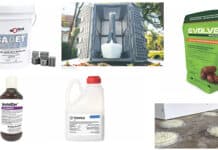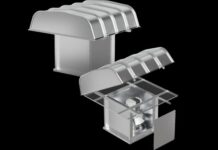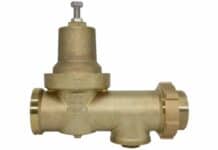By Jason Oberman
From the June 2024 Issue
When a pipe bursts inside a building, the impact is clear, and a facility manager is quick to respond. Interior water issues demand immediate action and prompt attention. What’s less obvious is the potential for water to significantly damage a property’s exterior.
Water issues are known to be a leading threat to one of the most expensive assets found on a commercial property — the parking lot. Unaddressed water issues can both dramatically decrease the amount of time between lot replacement and can also substantially increase the cost of lot replacement. Water is asphalt’s number one enemy.
The good news: water damage can be managed. Mitigating potential water damage and extending the life of a parking lot requires a plan. While there isn’t a one size fits all solution, there are certainly best practices to follow.

Start Here: Preventative Pavement Maintenance Methods
A water prevention plan for any parking lot should include a regular pavement maintenance schedule. Asphalt breaks down with time and wear; maintaining it is key to delaying this process.
Mitigating potential water damage and extending the life of a parking lot requires a plan. While there isn’t a one size fits all solution, there are certainly best practices to follow.
To prevent water damage within your parking lot, start by performing these four asphalt maintenance services:
Sealcoating: Much like the sun dries out our skin, the sun also dries up the oils exposed on the surface of an asphalt parking lot. As asphalt loses this binder oil, the lot becomes brittle and more prone to cracking and breaking. Even small cracks allow water to trickle through to the parking lot’s foundation where it begins to erode the stability of the lot. Regular sealcoating replenishes the all-important binder oil and assists in maintaining the asphalt’s structural integrity, while ensuring the base remains strong. Best practice is to begin sealcoating approximately one year after paving or repaving a parking lot. Continue sealcoating every two to three years, to ensure the asphalt is strong and protected.
Crack Sealing: How does it prevent water damage? Seemingly insignificant cracks are often just the tip of the spear with water intrusion. Cracks allow water to seep into the asphalt foundation and erode the base. When caught early, small cracks can be effectively filled with hot rubber to reestablish a watertight surface. How often should it be done? Rubber degrades over time and needs to be regularly reapplied. As a best practice, perform crack sealing every one to two years.
Sweeping & Drain Cleaning: How does it prevent water damage? Of all the methods mentioned in this article, this may be the easiest option. Regularly sweeping the parking lot removes debris that clogs drains and causes water to stop flowing. Litter, leaves and sediment that reach drainage points also need to be cleaned out to ensure a smooth flow of water and to prevent pooling.
How often should it be done? If possible, the lot should be swept once a week. This may need to happen more or less frequently based on the traffic volume. Drain cleaning is recommended once a year and also after heavy rainfalls or storms.
Asphalt Repair: How does it prevent water damage? Every property is familiar with the liability potholes present when it comes to customer accident prevention, but repairing these damaged sections also mitigates liability in the form of future parking lot investment. One of the most significant structural issues potholes present is a parking lot base exposed to water and further deterioration. This lack of structural integrity is also a concern in areas of concentrated cracking, where crack sealing is no longer cost effective or practical. Quickly repairing these localized areas restores the water barrier created by the pavement, avoiding larger issues that water damage to the base would create.
How often should it be done? A repair assessment should be performed every one to three years, although individually repaired areas should last much longer.
Troubleshooting Drainage Methods
If a robust maintenance plan is in place and there are still water issues, it may be time to review the parking lot design.
The best mantra applied to water in a parking lot is, “keep it moving!” Properly designed lots are able to prevent water from pooling and should move water away from the lot. If the water issues are significant, an engineering assessment may be required to determine if the lot is structured to deal with water effectively.
Here are some areas that may need to be addressed:
Does The Lot Maintain Proper Slope?
The slope of a parking lot directly impacts the effectiveness of a drainage system. In short, the correct slope ensures that water can effectively reach the drainage system collection points. Where there is no slope, there is no clear path for the water to drain.
If it appears the parking lot was constructed with an improper slope, the issue can be assessed and corrected by a qualified paving contractor. These professionals use specialized surveying equipment to measure elevations and existing inclines. At that point, the surface can be repaved to ensure each area of the lot has an ideal slope for proper drainage.
Is The Drainage System Up To The Task?
An effective drainage system is essential for moving water away from the parking lot and must be sized properly for the amount of water moving through it. The system should consider factors like the size and slope of the parking lot, rainfall patterns in the area, and soil conditions. A parking lot drainage system consists of several key components:
Catch Basins: If you see standing water in your parking lot, especially over an existing drain, or in a low lying area, you may need to upgrade your catch basins. Appropriately sized catch basins collect water runoff and channel it away, preventing standing water in a parking lot.
Pipes & Discharge Points: If the catch basin is the correct size, and there is still stagnant water, there may be an issue with the pipes connected to it. Underground pipes form a network that carry collected water from the catch basins and trenches to a designated discharge point. If the pipes are broken, clogged, or too small, water runoff cannot reach these discharge points.
Raised Curbs: Water sometimes needs a little help to follow the correct drainage path. Elevated curbs along the perimeter of the parking lot act like a guide, directing water runoff towards key drainage points like catch basins and trenches. If the lot doesn’t have elevated curbs—consider installing them.
Trenches: If water is collected in a small or enclosed space, a trench is a possible solution. Trenches are long, narrow channels installed below the pavement surface. They are ideal for quickly collecting surplus water. It’s important to note that trenches have limited collection capacity and may not be the best choice for collecting large volumes of water.
Does The Lot Have The Right Base?
It is impossible to prevent all water from reaching the base, so it is vital that the material the parking lot is built on does not retain water while also maintaining structural integrity. Subgrade allows some water to filter through while giving strength to the pavement above. Selecting subgrade materials according to the local conditions and specific traffic needs of the parking lot is vital to the longevity of the lot.
If the base does not drain water correctly, the foundation of the lot will soften or erode and create weak points. If the base drains well but isn’t strong enough for the traffic load, that can result in the base material shifting. Once again, the lot is vulnerable to breakage and potholes. In both scenarios, the base is exposed to additional water and the problem compounds.
Addressing improper base issues is often the true solution to ongoing parking lot deterioration, and new material may need to be installed.
Alternative Management Methods
If those traditional water management methods are ineffective or misaligned with your business goals, consider alternative solutions. Changing the pavement type or implementing strategic landscaping may help with the existing soil conditions and water runoff and can be both attractive and conscientious options.
Permeable Pavements: Permeable (also known as “porous”) pavements may not be the “go-to” choice for every parking lot’s water woes. However, they can be attractive options for parking lots that experience frequent heavy rain and flooding, environmentally sensitive areas, or in areas prone to the urban heat island effect. These pavement types can significantly reduce the stormwater runoff, putting less stress on the parking lot’s drainage systems and storm drain infrastructure.
In some areas, local regulations may incentivize permeable pavements to mitigate environmental impacts, which can help to offset capital investment, while giving businesses the opportunity to make a more environmentally friendly pavement choice.
Landscaping: Landscaping alone will not solve drainage issues, but it can be an aesthetically attractive and eco-friendly complement to a comprehensive drainage plan and well-designed parking lot. Here are some ways landscaping is used to support parking lot drainage:
- Swales: Swales are shallow, elongated depressions in the landscape that act like ‘mini-canals” to collect and slowly channel stormwater runoff. Planting shrubs and grass along the swales can further slow water flow, trap sediment and pollutants, and enhance aesthetics.
- Rain Gardens: Rain gardens are strategically designed landscaped areas with special soil mixes that promote infiltration of rainwater. Shrubs suited for moist soil conditions can be incorporated into rain gardens, playing a similar role to those planted in swales.
- Perimeter Plant Beds: Creating well-designed planting beds with shrubs around the edges of your parking lot can help with water management. The shrubs and their root systems help absorb some of the rainwater and act as a buffer, slowing down the flow of water and allowing more time for infiltration.
Preserving Parking Lots
Pavement for parking lots and structures must withstand the loads it will encounter to prevent premature failure. Read more…
While water is asphalt’s number one enemy, it doesn’t have to win. Addressing potential issues early and practicing preventive measures will help to protect the parking lot from water damage—and can prevent the need to invest in a mill and pave years earlier than the parking lot’s expected service life.
For more specific suggestions, consulting with a professional paving contractor or engineer is recommended. They can assess the specific parking lot, environment and drainage needs, and propose tailored solutions.
 Oberman is the Chief Operating Officer at Diamond Solutions. Diamond provides facility managers with a simple, clear, and fast parking lot management experience.
Oberman is the Chief Operating Officer at Diamond Solutions. Diamond provides facility managers with a simple, clear, and fast parking lot management experience.
Do you have a comment? Share your thoughts in the Comments section below, or send an e-mail to the Editor at jen@groupc.com.














 Preserving Parking Lots
Preserving Parking Lots




![[VIDEO] Job Order Contracting: Accelerating the Projects that Matter](https://facilityexecutivemagazine.kinsta.cloud/wp-content/uploads/2024/05/maxresdefault-324x160.jpg)
